
Harvest of Grief, a new documentary directed by Anwar Jamal recently premiered in Punjab. The film aims to tackle the rising number of farmer suicides in Punjab.
Harvest of Grief is a 60 minute documentary of farmers’s suicides in the dry district of Sangrur. Suicides are due to indebtedness arising out of high costs of water, mechanized farming, chemical pesticides and fertilizers and low economic returns. The film also takes a comprehensive view of gender, health and environmental destruction which are the consequences of the Green Revolution and globalization. [link]
The movie is sponsored by the Rescue and Revival Mission and predominantly focuses on the impact the suicides have had on women and children. A recent article in the Financial Times also discussed Harvest of Grief and the issue of famer suicides in Punjab. Official statistics say that 132 farmers in Punjab killed themselves in the past five years – attributing the deaths to natural causes or alcohol or drug abuse. However, Inderjit Singh Jaijee, a Chandigarh-based human-rights activist and former state legislator, states that up to 40,000 farmers have taken their lives in the past 20 years. A large discrepancy in the number of farmer suicides exists (perhaps due to a lack of infrastructural support, social stigma etc.) and families are often left destitute, receiving little or no state support.
I look forward to watching the film and hope it creates productive dialogue leading to potential solutions for families impacted and affected by this issue.
Guest blogged by Harbakhsh Grewal
At the start of this year BBC 1, Britain’s premiere tv channel, highlighted the importance of 1984 to the Sikh psyche with a film documenting the personal journey of a British Sikh woman, journalist Sonia Deol. The reaction from many Sikhs has been hostile and vocal. Did the programme insult the faith, demonise its leaders and miss a massive opportunity to set the record straight as some have claimed? And even if it did, does the presenter deserve the vitriolic response resulting in her deleting her facebook page to avoid any more abuse?
Whatever the rights and wrongs of the programme, the response to it shows the level of concern still in the community to the tragic and horrific events of 1984. However some of the criticism has been purely personal and deeply unpleasant and does nothing to redress the balance or aid the causes that those who are angry care about.
To discuss the programme in any detail requires much deliberation. And that in a sense is why the programme should be applauded: the issues covered were of such enormity and complexity the programme makers should be congratulated for daring to cover them at all in the first place – and to try and do so within an hour slot is a task of great difficulty.
And the fact that many younger Sikhs, as well as the wider non-Sikh public more generally, have discovered a whole chapter of their own community’s history in some depth and breadth I think shows that the BBC has provided a much needed service.
Those who criticise on specific issues such as the portrayal of Bhindranwale have their own points to make. But they seem at times illogical.
This time, Bollywood actually picked an interesting lens through which to depict life in a Punjabi-Sikh household. An 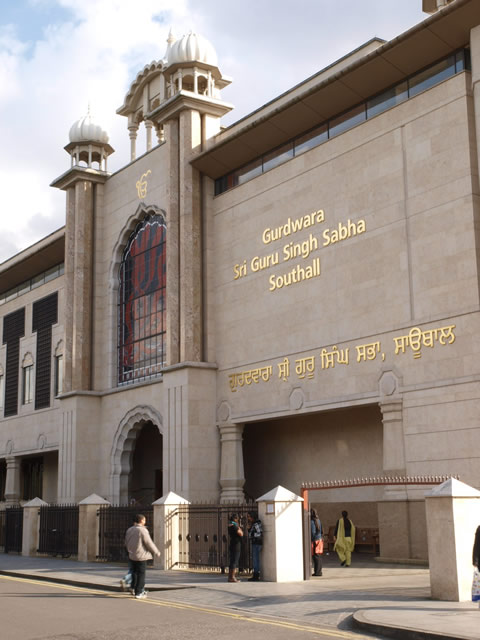 upcoming movie, Patiala House, is a look at cross-generation cultural assimilation in Southall.
upcoming movie, Patiala House, is a look at cross-generation cultural assimilation in Southall.
At heart, says Nikhil, Patiala House is a father-son story. “Like Billy Eliott where the father is a coal miner but the son wants to be a dancer. In my film, Rishi Kapoor feels his dreams as a Sikh immigrant in England are being destroyed by his son. But the son Akshay Kumar has his own dreams to pursue.” [TOI]
How we view our 2 pronged identity of Punjabi-Sikhism, and how each is depicted by outside communities such as Bollywood is often, understandably and rightfully, a controversial issue. But Patiala House seems only superficially concerned, if at all, with the Sikh identity.
The filmmakers met with Sikh elders at the Southhall Gurdwara, where cameras are ordinarily not allowed, to talk about the ideas behind the film. The film partly takes place during Southhall’s 1979 race riots, which many of the elders had lived through.
I normally only watch Bollywood, if ever, to laugh. At the acting, the ridiculous stereotypes, the loony drama.
Though when the bad acting, ridiculous stereotypes, and loony drama are played out by Sikh characters, it’s a little depressing.
A lot of people would probably say that the quality of films coming out of Bollywood is improving. And that might be true if you’re talking about cinematography, but when it comes to depth in a plot, I haven’t seen any signs of improvement. But maybe Bollywood will pleasantly surprise its critics with Rocket Singh?

Last weekend I attended the Sikh Lens Sikh Art and Film Festival in Hollywood. I have attended film festivals all over North America and strongly believe in their need and presence in our community. Many times, however, the events get overshadowed by the glitz and glamour – the red carpet, the photographers, the eccentric outfits… I was therefore grateful that my experience at the Sikh Arts and Film Festival was a fulfilling one – I left knowing that Sikh Arts and Films bring value to our community and need to be supported. In addition, I felt the organizers made a special effort to keep the event focused on the directors, artists, musicians, actors, authors and organizations who were present. They recognized the fact that we are all in this together. Sikh Arts and Films are only beginning to be acknowledged, there is so much potential and growth that will still occur. However, this isn’t going to magically happen overnight, and it most definitely won’t happen without the community’s support.
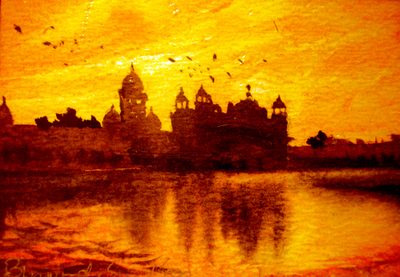 I was recently told that Sikhs in the UK spend 7 times more on license plates than they do on books (yes, 7 times!). While I’m not sure of the statistic in the US, the point is clear – perhaps we’re not investing in the right places? I think as a community we have begun to establish the need to support non-profit organizations that are working to address human rights, legal, education and activism issues (although we still have a long way to go to enhance our support). However, what goes hand in hand with this is the support and advancement of Sikh Art and Media. Without a doubt, events such as Sikh Lens are helping to pave the path – however, we as a community need to ask ourselves why we are so hesitant to spend money on independent films, children’s books, on historical references and on paintings. When I think about other immigrant communities, I notice that their advancement as a community comes from their support of one another. Whether we like to admit it or not, our community is extremely frugal and competitive with each other, and unless we start to move away from those stereotypes – we will not be creating a better world for our children.
I was recently told that Sikhs in the UK spend 7 times more on license plates than they do on books (yes, 7 times!). While I’m not sure of the statistic in the US, the point is clear – perhaps we’re not investing in the right places? I think as a community we have begun to establish the need to support non-profit organizations that are working to address human rights, legal, education and activism issues (although we still have a long way to go to enhance our support). However, what goes hand in hand with this is the support and advancement of Sikh Art and Media. Without a doubt, events such as Sikh Lens are helping to pave the path – however, we as a community need to ask ourselves why we are so hesitant to spend money on independent films, children’s books, on historical references and on paintings. When I think about other immigrant communities, I notice that their advancement as a community comes from their support of one another. Whether we like to admit it or not, our community is extremely frugal and competitive with each other, and unless we start to move away from those stereotypes – we will not be creating a better world for our children.
 This weekend Sikhlens will be presenting its annual Sikh Art and Film Festival 2009. The film festival showcases the best in Sikh movie-making talents from around the globe. It also presents a forum for aspiring Sikh artists to also come and display their burgeoning talents. A few book launches are planned with a particular emphasis on children’s books. Authors of A Lion’s Mane and The Royal Falcon are planned to be in attendance to do a live reading.
This weekend Sikhlens will be presenting its annual Sikh Art and Film Festival 2009. The film festival showcases the best in Sikh movie-making talents from around the globe. It also presents a forum for aspiring Sikh artists to also come and display their burgeoning talents. A few book launches are planned with a particular emphasis on children’s books. Authors of A Lion’s Mane and The Royal Falcon are planned to be in attendance to do a live reading.
The inaugural Sikh Art and Film Festival will be held at the historic Egyptian Theatre in Hollywood, CA on November 13-15th.
In previous articles on The Langar Hall, I have written about how certain Sikh-film haters groan in jealousy and spew hatred, about the Sikhs’ taking advantage of new forms of media. Such efforts in the community should be encouraged and more platforms created.
The weekend features a number of different clusters, highlighting issues on the youth, creative Sikhs, short films, feature films, and even Remembering 1984. The Remembering 1984 cluster on Sunday afternoon will be co-hosted with the Jakara Movement in conjunction with it’s Visions of Truth film series.
So whether you come for the entire weekend, make it out to just one cluster (at $15 pre-sale, you won’t find a better price), or at least to Sunday’s mela, check the schedule, check out the films, and make sure you come out and support Sikh arts! We’ll be in attendance and will post on our experience after the event.
Sir Javai Te Javai, Mera Sikhi Sidak Na Javai
If I lose my head, so be it. But I must not lose my Sikhi.
After 16 months of tremendous effort and hundreds of thousands of dollars in spend, the Vismaad team brings us their fourth animated Sikh film, Bhai Taru Singh. We’ve blogged about the film before and about Bhai Taru Singh’s legacy. Now having had the privilege of watching the film last weekend, I’d like to share a few thoughts.
In years past, during the quickly cooling evening hours of dusk a Sikh child would huddle up next to their grandmother for the warm not only of her body and but also her captivating stories. Night after night, Beji would weave together real life tales of Sikh courage and bravery, instilling a sense of intrinsic pride, faith and determination that would provide a foundation of strength for young Sikhs in an unfriendly world.
But things have changed. Hectic schedules, disconnected families, ubiquitous technological distractions, and language issues have made these kind of life moments a rare occurrence. Whereas the Sikh panth has relied heavily on, and benefited from, its rich oral traditions, the current lack of intra-generational transference is a major concern. What are Sikhs without their history? Who else begins every supplication to the Creator by remembering and reflecting on their entire history? However, the Ardas we recite daily is only shorthand summary of our history, so what relevance does it hold, if you don’t actually know why we say charkrian de chare, aarye naal charai gaye, or sikhi kesan suasa naal nibhayi? So it is into this vacuum that a movie on Bhai Taru Singh attempts to fill a void.
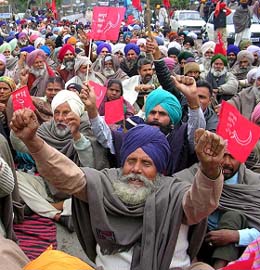 While I do value the role films play in telling stories, I wonder if at times it can do more harm than good. I recently heard about a new bollywood movie called Kisaan and had the opportunity to watch it last night. I had been told the movie was about farmer suicides in punjab and while i was aware it was a bollywood production, I definitely made time to watch it as it is such an important issue.
While I do value the role films play in telling stories, I wonder if at times it can do more harm than good. I recently heard about a new bollywood movie called Kisaan and had the opportunity to watch it last night. I had been told the movie was about farmer suicides in punjab and while i was aware it was a bollywood production, I definitely made time to watch it as it is such an important issue.
The movie touched upon issues such as the role illiteracy and dowry play in the lives of farmers – the reality of poverty overpowered by the hope of prosperity. These are important issues and should be discussed. Films are an important tool to utilize in order to raise awareness about such issues.
Suffice it to say, Kisaan is a bollywood production and is distracted by it’s commitment to bollywood requirements. I can’t say i wasn’t disappointed – this is such an important issue which needs to be explored. While i commend the director for attempting to raise the issue, i do question if this genre of film was the best vehicle for it. The issue was so entangled in the film, mixed in with songs and awkward jokes, that i can’t imagine how serious the issue will be taken.
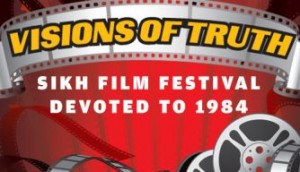 Last week, Reema discussed the dynamic Punjabi-Sikh art scene. We’ve come a long way, especially in the field of film and media with a growing number of films by, for and about Sikhs. Now, you can attend Sikh film festivals in every corner of the country and even internationally. In addition to this, Sikhnet recently announced it’s 2009 Youth Online Film Festival. This online film festival is especially significant as it offers young inspired Sikhs an opportunity to showcase their creativity on a positive platform. Films such as turBAN, a film by Dashmesh Pictures and G.N.E., provides an “artistic editorial challenging current regulations invoked in the French public school system.” Each film plays an important role in portraying Sikh stories in creative ways.
Last week, Reema discussed the dynamic Punjabi-Sikh art scene. We’ve come a long way, especially in the field of film and media with a growing number of films by, for and about Sikhs. Now, you can attend Sikh film festivals in every corner of the country and even internationally. In addition to this, Sikhnet recently announced it’s 2009 Youth Online Film Festival. This online film festival is especially significant as it offers young inspired Sikhs an opportunity to showcase their creativity on a positive platform. Films such as turBAN, a film by Dashmesh Pictures and G.N.E., provides an “artistic editorial challenging current regulations invoked in the French public school system.” Each film plays an important role in portraying Sikh stories in creative ways.
Another notable film-related event is Visions of Truth, a traveling film festival devoted to showcasing films about 1984. The film festival will be held during the months of September and October in eight regions in California including: Yuba City, Sacramento, San Jose, Fresno, Los Angeles, Irvine, Riverside and San Diego.
The goal of “Visions of Truth” is to spur dialogue between members of the community by showcasing film and music media related to the third Sikh holocaust (1984). This event remains one the most significant, events in the history of Sikhs. In early June 1984 the Indian Army invaded one of the most historic of all Sikh Gurdwaras, the Darbar Sahib complex in Amritsar, Punjab. The ensuing destruction and loss of life marked one of the darkest chapters of the later 20th century for Sikhs. The aim of the film festival is not only to remember the events of 1984 but also to raise awareness in the community and promote positive dialogue. [link]
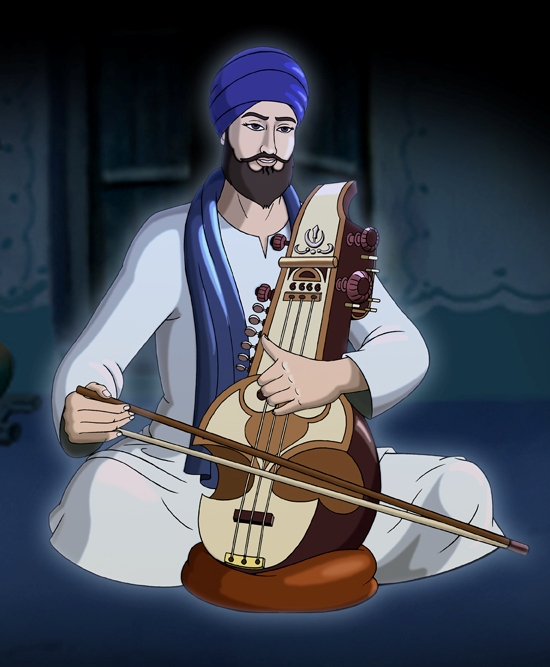 For those of you who enjoyed Vismaad Productions’ work with Sahibzadey, Rise of the Khalsa and Sundri, there is now a new animated movie to look forward to this fall. Bhai Taru Singh: True Saint. Fearless Soldier, is the latest production and will be premiering around the world over the next few months. The film’s website provides a description of the film,
For those of you who enjoyed Vismaad Productions’ work with Sahibzadey, Rise of the Khalsa and Sundri, there is now a new animated movie to look forward to this fall. Bhai Taru Singh: True Saint. Fearless Soldier, is the latest production and will be premiering around the world over the next few months. The film’s website provides a description of the film,
The story of Bhai Taru Singh is one of a true saint soldier who lived during an extremely difficult period for the Sikhs. The mughal rulers of the time were brutal towards all citizens, and especially the Sikhs. Bhai Taru Singh Ji bravely stood up to the regime which earned him the respect of all Hindus and Muslims from the surrounding villages. [link]
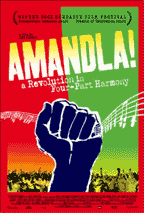 Years ago, I watched this beautiful documentary called Amandla (Xhosa word for “power”)
Years ago, I watched this beautiful documentary called Amandla (Xhosa word for “power”)
It chronicles the struggle of the Black South Africans when the apartheid government came to power in 1948. It also covers the decades of increasing violence and repression, then finally “victory” in 1994 when Nelson Mandela became South Africa’s first democratically chosen president.
I’ve always been fascinated with the Black South African movement against apartheid and have read, listened, and watched much about it. What was so unique about this film was it focused on the music of the movement, and how the power of song was used to communicate, motivate, console, unite and, ultimately, beget change.
I really connected with this film as it made me think about Shabad Keertan and in particular – Vaars, and how it may have been used to motivate and inspire the Khalsa during battle. I would strongly recommend this documentary for a film discussion at any Gurmat camp or retreat. If anyone has seen it, I would love to hear your review!
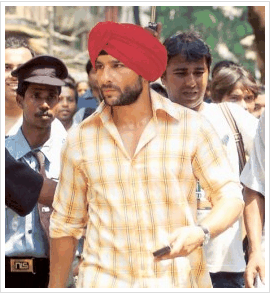 I’ll admit…Bollywood movies were boycotted and banned in my household as far back as I can remember, so maybe these “religious sensitivity pre-screenings” are common…but the course of events surrounding this new movie is still quite strange…even for Bollywood’s standards.
I’ll admit…Bollywood movies were boycotted and banned in my household as far back as I can remember, so maybe these “religious sensitivity pre-screenings” are common…but the course of events surrounding this new movie is still quite strange…even for Bollywood’s standards.
Last week, a new movie titled “Love Aaj Kal” was released, with Saif Ali Khan playing a Sikh as the lead male role. However, shortly before the release, the Punjab Cultural and Heritage Board objected to his portrayal of a Sikh.
Explaining their stand, Charan Singh Sapra, President of Punjabi Cultural And Heritage Board informed a tabloid, “We are objecting on the grounds that Saif is shown with a very trim beard.”
Long story short, after Khan’s formal apology and a paparazzi-filled press conference at Guru Singh Sabha Gurdwara, Dadar – 15 seconds of a questionable scene was cut from the movie and Khan declared he would not portray a Sikh “incorrectly” again in future roles. All smiles, the Punjabi Cultural And Heritage Board gave the movie “two thumbs up” and the green light to proceed.
I guess I should be happy that an organization is concerned enough about the image of Sikhs to raise such a fuss…except for the fact that we’re talking about fantasy-land. My question is…where is the organization that cares about the Sikh image in real life?
 Turbanology, or knowledge of Turbans, is a TV documentary recently released in the UK which explores the meaning of the turban in England since the London bombings. Filmmaker, Jay Singh-Sohal, was working for a conservative think-tank in the US when he first began considering the misconceptions surrounding the turban and the subsequent profiling of individuals and communities. The documentary discusses the origin and importance of the turban in modern Britain to “see whether it’s just harmless headwear or really the fashion of a fantatic”.
Turbanology, or knowledge of Turbans, is a TV documentary recently released in the UK which explores the meaning of the turban in England since the London bombings. Filmmaker, Jay Singh-Sohal, was working for a conservative think-tank in the US when he first began considering the misconceptions surrounding the turban and the subsequent profiling of individuals and communities. The documentary discusses the origin and importance of the turban in modern Britain to “see whether it’s just harmless headwear or really the fashion of a fantatic”.
The film addresses the impact 9/11 and 7/7 has had on the [mis]understanding of the turban as a symbol of fear, hatred and global terrorism. Australian researchers at the University of New South Wales published a study in 2008 which found that simply noticing someone could be a Muslim increased the aggressive tendencies on the part of non-Muslim westerners. They called it the “Turban Effect.” Turbanology seeks to raise awareness of the turban’s importance and discuss why the people who wear it consider it a crown. In the documentary, Jay Singh-Sohal speaks to music producers, politicians and ordinary Sikhs and Muslims who have been affected by wearing a turban. (A preview of the documentary can be seen after the jump).
“The documentary discovers that simply noticing someone could be a Muslim increases the aggressive tendencies of westerners. The give-away sign is the turban, and the beard. Whether conscious or sub-conscious, the fact that terrorism is a worry for many people means that there’s been a rise in profiling who could be a threat – an issue explored in the piece.” [link]
He locked the washroom door, unravelled the nine-metre turban, took a pair of scissors and started cutting. Ten minutes later, three feet of hair lay in a pile and Charanbir Singh sat down and cried.
Outside, his parents and grandmother were in tears. Two friends persuaded him to come out, but Charanbir, his head wrapped in a towel, rushed to his room.
That was a year ago. Charanbir, now 17, still shudders at the memory. “I had to cut my hair.” (Link)
One of ironies of life in the 21st century western world is that despite an unparalleled degree of freedom of religion, the majority of people seem to be opting for freedom from religion.
Last week, Raveena Aulakh, a reporter from the Toronto Star, put a Canadian twist on the worldwide issue of apostasy amongst Sikh Youth.
Sikhism dates back to 15th-century India. Adherents are required to not cut their hair, considered a visible testament to their connection with their creator. The turban was adopted to manage long hair and make Sikhs easily identifiable.
For many young men in Greater Toronto, that is the problem: They don’t want to stand out.
Like other new or second-generation immigrants, many Sikh youngsters are desperate to fit in with the school crowd, while others complain of racism because they wear the turban. Add to that cultural influences, peer pressure and the desire to assimilate.
The end result? Many youngsters cut their hair, leading to family friction and, in some cases, lasting estrangement.
As a counterpoint, in the article and video above, Pardeep Singh Nagra (of boxing fame) presents his thoughts on why he’s decided to keep his hair.
Fear & Guilt
I’ve often wondered why so many Sikh youth keep their hair through high school but cut it as soon as they feel free from their parent’s control? From my perspective I see this as symptomatic of a great challenge facing Sikhs around the world today. Somehow, someway, we have fallen into the trap of pushing Sikhi to the next generation with fear and guilt, rather than sharing Sikhi through love.
Take your typical Sikh family; actually take mine. My now 25 year old cousin in Punjab had wanted to cut his hair since he was a teenager but two things stopped him. He was afraid that if he cut his hair his dad would beat him and then disown him. Secondly, he knew that if he did get a haircut and shave he wouldn’t be able to look his crying mom in the eye.
Unfortunately, there was little positive reinforcement around Sikhi in his life. Sure there was Sikhi by osmosis: visiting Gurdwaras, gurbani playing in the background, the odd sakhi told by our visiting grandfather. However, my cousin had little exposure to the aspects of Sikhi (nitnem, kirtan, seva, simran) that would have connected him with his faith on a deeper level. Most of the discussions with his parents were a flavour of the famous Goodness Gracious Me clip. So not surprisingly, upon entering college, he too cut his hair. And sure enough, he became our family’s black sheep, making a kid with already low self-esteem, feel even worse.
Kes is an important part of the Sikh identity but it also carries social, cultural, and political meaning for more than just Sikhs. Recently, a film student from NYU explored this less explored cross-cultural perspective by speaking with 3 individuals from various backgrounds in an interesting (and short-18 minute) documentary.
The film engages with a Sikh (Sonny Singh from the Sikh Coalition’s New York office), an African-American woman, and a woman with trichotillomania – a disorder that causes the sufferer to compulsively pull out hair. We often consider kes in the context of religion, beauty, and identity; but rarely do we do so in a cross-cultural perspective (unless you grew up in a culturally diverse community). The film is thoughtful and thought-provoking, so I’ll let it speak for itself. It includes footage from the recent Sikh Day parade in New York City, as well as a pagh tying competition in Richmond Hill.
[hat tip: sonny]
Hair… As one of the most important aspects of how others see us, how has our hair become interwoven with issues of race, religion, beauty, and identity?
Sikhism mandates that the hair is never cut. We explore the rationale behind this and the discrimination that Sikhs face today in a post 9-11 world.
Many women of African descent grow up to think negatively about their natural hair. So begins the burdensome, expensive, and often painful process of weaves and chemical straightening, as a however subconscious attempt to achieve a homogenized concept of beauty. We speak to a woman who takes pride in her natural hair and is committed to show others how truly beautiful “nappy” hair can be.
Sometimes what we do with our hair is not a choice. Trichotillomania is a disorder that causes the sufferer to compulsively pull out hair. We will meet a long-term lash/brow puller who describes how people have reacted to her disorder and how these experiences have shaped her. [link]
Yes, I’m going to dare to talk about a film other than Slumdog Millionaire. This past weekend, I watched a film called Amal and I can’t stop thinking about it. While this movie has been shown at several independent film festivals, it hasn’t received the attention I think it deserves (actually, perhaps that’s a good thing – those films that get hyped are often dissapointing!). The story is quite simple,
AMAL, a multi-layered portrait of contemporary India, follows an auto-rickshaw driver in New Delhi (Amal) who is content with his small, but vital role in life. One day he drives an eccentric billionaire who, disguised as a vagabond, is searching the streets for the last morsel of humanity, and someone he can leave all his money to, and Amal’s life may change forever. AMAL serves up a visual feast for audiences. Filmed on location in New Delhi, India, this modern day fable asks the important question of what success means to each individual and ultimately reveals to audiences that the poorest of men are sometimes the richest.
It seemed pretty significant to watch this film during these pressing economic times. Amal, the lead role in the film, is played by Canadian actor Rupinder Nagra. A small role in the film is also played by Gurpreet Chana (The Tabla Guy). Gurpreet composed some of the music for the film too. If you manage to get your hands on this film, you won’t be dissapointed. In the meantime, here’s the trailer:

We have talked about ‘Slumdog Millionaire’ many times here at TLH. We have criticized the corporate double-standards, celebrated dhols, and even discussed ways to get involved.
Yes, many have jumped on the Slumdog bandwagon (TLH included!). However, this one takes the cake. The Congress-led UPA government in Delhi now counts Slumdog’s success as one of the government’s accomplishments.
In an unmistakable resonance of the previous NDA government’s `India Shining’ slogan, Congress floated the idea of an `achieving India’ and listed among the milestones the Indo-US nuclear deal, Chandrayaan, near 9% growth and the total sweep of the Oscars.[link]
I wonder – is the government celebrating its role in the creation of the slums? The facts don’t seem to lie as one article wrote:
Fact: The number of people living below the poverty line has actually increased by a horrifying 20 per cent. India had some 270 million people below the poverty line in 2004-5, when the present Government took office. That number has gone up by 55 million, or 20 per cent, after five years of policies named after the ‘aam admi’ (common man) but shaped for the ‘khaas admi’ (vested interests).[link]
The ridiculousness didn’t stop there.
 While many may still be reveling in Slumdog’s Sunday limelight, a darker movie about Indo-Canadians in Vancouver (the vast majority of who are Punjabi-Sikh), aiming to shed light on gang violence, is sparking criticism. [See trailer here.]
While many may still be reveling in Slumdog’s Sunday limelight, a darker movie about Indo-Canadians in Vancouver (the vast majority of who are Punjabi-Sikh), aiming to shed light on gang violence, is sparking criticism. [See trailer here.]
The film titled “A Warrior’s Religion” was made by Mani Amar, who describes it as a poetic documentary. When asked about what drove him to make the film, he said:
“It had to be done. How many more people need to die? We are past the 130 mark of deaths in our community. The issue is not slowing down … How readily we have accepted gang violence and how engrossed we are in it is what propelled me to do it. We are so relaxed about an issue that we should not be relaxed about at all.” [link]
In the film, Mani interviews Bal Buttar, a high-profile former gang member who is now blind and a quadriplegic after being shot in a gang related incident.
Mani said: “When I met Buttar, I laid it out on the table directly to him and said to Buttar, “I don’t respect you. You have an opportunity in your life to show youth that this is what gang violence will bring you.” For whatever reason, Buttar accepted the challenge. In the end though, I reaffirmed that it’s only death or jail to get out.” For Mani, what resonated most from the interviews was Buttar’s way of explaining karma: “You take blood. That blood gets taken from you.” [link]
Controversy has arisen from the film’s name, “A Warrior’s Religion,” and its use of visual references to Sikhism through images of gurdwaras, scenes from a Vaisaikhi parade, martyrs, and an image of a khanda in flames with bullet holes in the background. Mani explains how he chose the name:
The Center for Asian American Media (CAAM) is a group working to present stories that convey the “richness and diversity of Asian American experiences” to the broadcast audience. They do this by funding, producing, distributing and exhibiting works in film, television and digital media. One example is this video directed for Mandeep Sethi, a bay area MC. As he says, Where do we go from here, I thought my people would be proud of their heritage and instead they want to bury it.
Also presented by the Center, is the upcoming 27th Asian American Film Festival in San Francisco. For those of you in the area, here are some of the films you might want to catch.
 Michael Singh, a filmmaker, has been attempting for years to finish a documentary on his experiences during 1984. However, without support from the Sikh community (yes, money) he has found himself unable to complete this work. His goal has been to make a one-hour documentary based on materials he recorded and filmed during three days in Delhi when mobs were roaming outside the compound where he and his brother Surinder were staying.
Michael Singh, a filmmaker, has been attempting for years to finish a documentary on his experiences during 1984. However, without support from the Sikh community (yes, money) he has found himself unable to complete this work. His goal has been to make a one-hour documentary based on materials he recorded and filmed during three days in Delhi when mobs were roaming outside the compound where he and his brother Surinder were staying.
The documentary-film-in-progress Riding the Tiger will recount filmmaker Michael Singh’s personal and intimate journey into self-identity as a half-Sikh young man who survived the atrocities of 1984, denying his Sikh heritage and passing for a white man. His story is set against the backdrop of the bloodiest year in modern Sikh history, a year of which many young Sikhs know little. [link]
The filmmaker is concerned that the traumatic events of 1984 are “quickly fading” from the Sikh consciousness and is asking the community, “How serious are you about preserving Sikh culture?” Micheal’s story begins when he and his brother return home, to India. After Prime Minister Indira Gandhi lay siege on the Sikh’s holiest site, Michael and his brother Surinder managed to infiltrate it and view the destruction following the gunning down of hundreds of pilgrims. Upon returning to the US Micheal publicized his story, and to his delight, three Sikh film producers showed up at his apartment, expressing their desire to hear his interviews and bankroll his film. Michael tells us of the tragedy of this visit,

